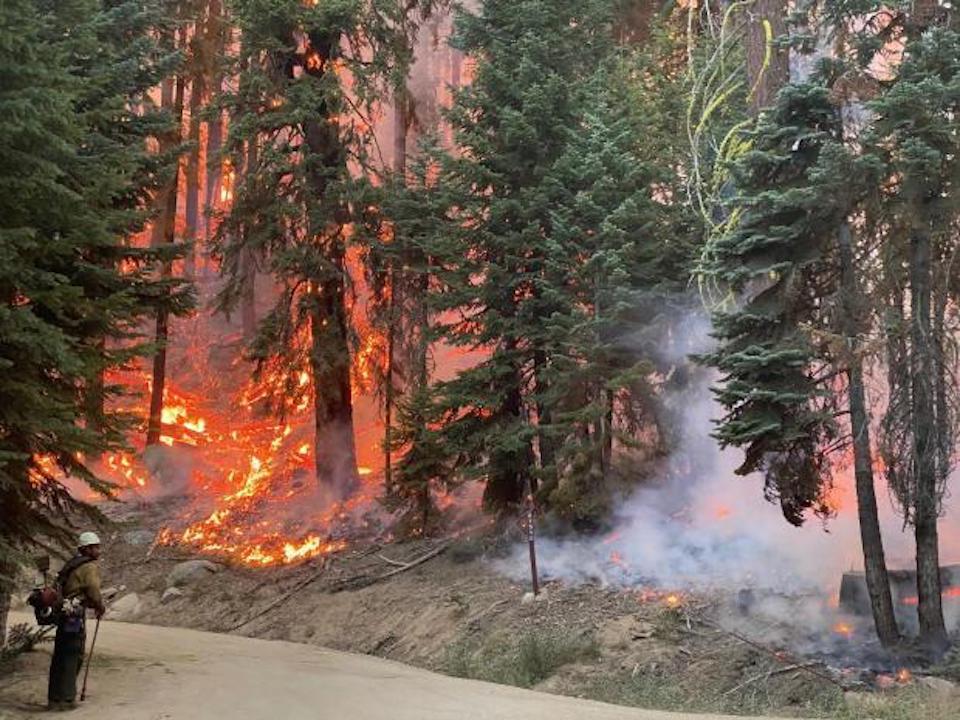
The SQF Fire Saturday morning/USFS
A wildfire complex south and west of Sequoia National Park forced closure on Monday of a section of the Generals Highway in the park.
The section running from Highway 198 in Three Rivers, through the Ash Mountain Entrance Station, to the Giant Forest Museum closed at 6 a.m. local time Monday. No reopening date was announced.
The SQF Complex, composed of the Castle and Shotgun fires that were sparked by lightning on August 24, covered more than 89,000 acres Monday morning and was 12 percent contained. Both fires are located in the Sequoia National Forest. The majority of the Castle Fire is in the Sequoia National Forest, but it is also burning in the Inyo National Forest.
Low relative humidity levels and warm temperatures were expected to contribute to extreme fire activity Monday, a fire incident report stated. The northern edge of the fire could begin to impact Sequoia National Park.
Visitors can reach Sequoia National Park by heading for the Big Stump Entrance Station on Highway 180 from Fresno.
"Our No. 1 priority is public and employee safety. It is crucial to take care of our staff and our gateway community of Three Rivers," said acting Superintendent Lee Taylor. "With this partial park closure, it is our intention to reduce possible evacuation complexity of the Three Rivers community by reducing the number of visitors there."
Along with closing that section of the Generals Highway, the park also announced closure of the Potwisha Campground. All reservations were to be canceled and refunded, a park release said.
While the Giant Forest was expected to remain open, including access to the General Sherman Tree, the Crescent Meadow Road, which provides access to Tunnel Log, Tharp's Log, and Moro Rock, were closed. Also closed was public access to the Mineral King Road.



Comments
My heart breaks for all the trees being lost . Please be safe !!!
Please do what ever you can to save the giant redwoods !!! I can't imagine living in a world without them !!!!
Devastating. I used to go to a summer camp in SNP every summer. The place was majestic in every way imaginable. Being a native Californian, I have enjoyed our national parks my entire life. I have a question for the group. I was told that logging in National Parks stopped due to environmentalists and that this, in turn, has contributed to these massive fires. Is this true? I read the pollution caused by these fires just this year alone has negated twenty years of environmental conservation. Is this true? I would appreciate a response from those that know the facts.
I think it's logging in Sequoia National Forest that was stopped. Sequoia National Park I believe hasn't allowed logging of any sort for many years. Sequoia National Park is surrounded by Sequoia National Forest. Now there's also Sequoia National Monument which was created from the National Forest. All entities have different managements with their own regimen. I know there was clear cutting in Sequoia National Forest as of thirty years ago, because I saw some. This is all very sad.
Cecile - don't be too concerned for the giant trees. They are "giants" because they have a natural defense to fires.
They should have never stopped the Forestry Service from doing the control burns to clear out the underbrush. It's awful to lose all those beautiful trees.
In all but a very few areas, logging on lands designated as national parkland has been prohibited since their inclusion in the National Park system. You are perhaps confusing national parks with national forests, which have a completely different managment mandate and are not even administered by the same branch of the U.S. government. Research in Oregon and elsewhere has shown that logging actually increases the severity of fires because the removal of large dominant trees (the ones that provide the most marketable and valuable timber) changes the relative humidity within the forest and makes it more vulnerable to drying and wind-throw, and hence ultimately more flammable. Both Yosemite National Park and Sequoia-Kings Canyon National Park have active programs of prescibed burning and prescribed natural fire, to re-establish more natural fire regimes (and mimic the burning practices of Native peoples, whose use of fire shaped California ecosytems for many millenia before the arrival of Europeans) and to deal with the build-up of fuels on the landscape. Fire ecology studies indicate that the fire return interval in the Sierra (depending on the location and the vegetation type) averages 8-15 years, and historically fires were low-intensity and did not result in crown fires which incinerate everything in their path. Climate change has resulted in higher temperatures throughout the year, but especially in summer, when California's Mediterranean climate contributes to long periods without significant rain. Hence we see the deadly combination of fire suppression with accompanying fuel build-up, and the impacts of climate change and long-term drought, creating mega-fires and explosive fire behavior never before witnessed by firefighters with decades of experience in the western United States.
What you were told is propaganda used by those who want to attack environmentalists so that people won't admit that this is connected to climate change.
They didn't stop it. They had controlled burns just last year.